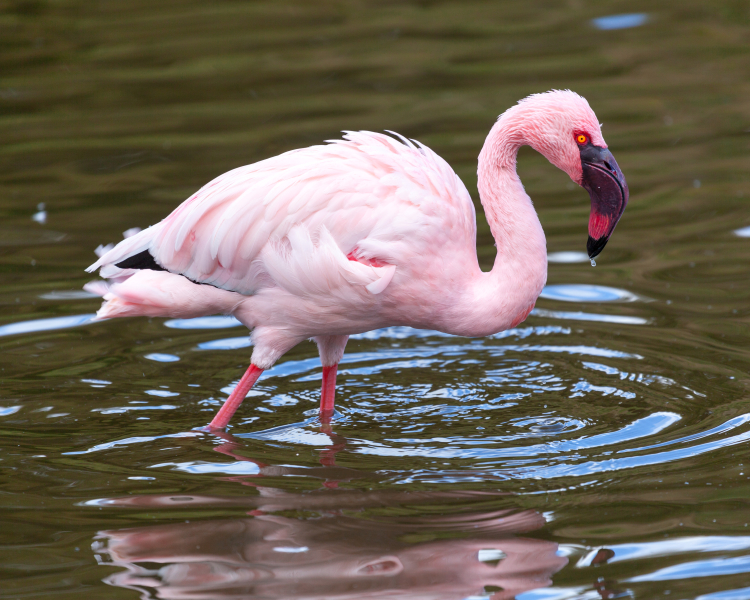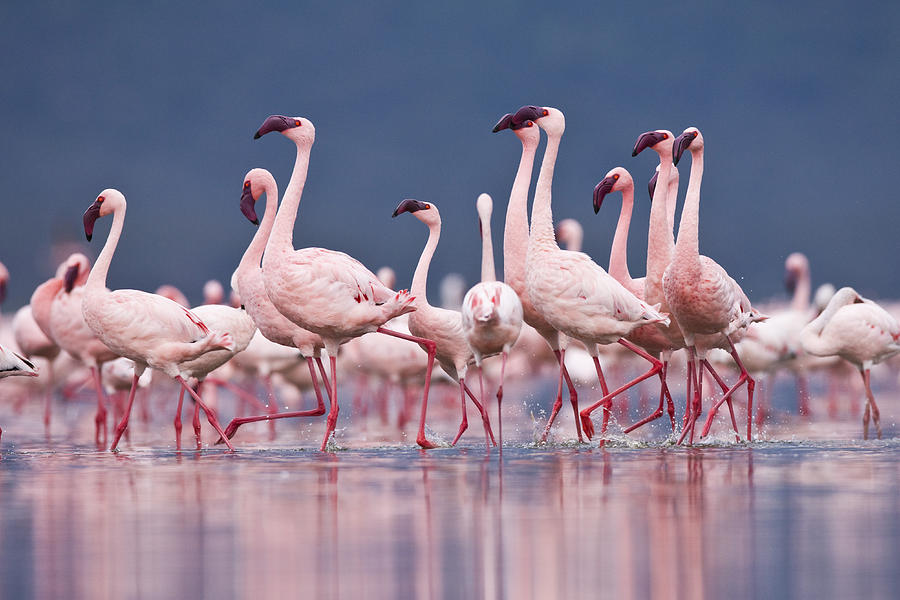The Lesser flamingo is the smallest of all flamingos but has the largest population. Lesser flamingos inhabit coastal and inland wetlands of sub-Saharan Africa and they breed on large alkaline and saline lakes, salt pans, and coastal lagoon.
The lesser flamingo is the most common species of flamingo, with a population of approximately two million individual birds. This species feeds primarily on Spirulina, algae which grow only in very alkaline lakes. The presence of flamingo groups near water bodies is an indication of sodic alkaline water which is not suitable for irrigation use. Although blue-green in color, the algae contain the photosynthetic pigments that give the birds their pink color. Their deep bill is specialized for filtering tiny food items.
Like all flamingos, they lay a single chalky-white egg on a mound they build of mud. Chicks join creches soon after hatching, sometimes numbering over 100,000 individuals. The creches are marshaled by a few adult birds that lead them by foot to freshwater, a journey that can reach over 32km(20 mi).
Learn why Flamingos are Pink in color.
 Despite being the most numerous species of flamingo, the lesser flamingo is classified as near threatened due to its declining population and the low number of breeding sites, some of which are threatened by human activities.
Despite being the most numerous species of flamingo, the lesser flamingo is classified as near threatened due to its declining population and the low number of breeding sites, some of which are threatened by human activities.
The population in the two key East African lakes, Nakuru and Bogoria, have been adversely affected in recent years by suspected heavy metal poisoning, while its primary African breeding area in Lake Natron is currently under threat by a proposed soda ash plant by Tata Chemicals.
Habits and Lifestyle of the Lesser Flamingo
Lesser flamingos do not migrate and they live in big colonies with sometimes more than 1 million birds. They are mostly active at night. They fly between water bodies in large, V-shaped formations when food sources have become depleted. Even when food is plentiful, flocks may sometimes fly between water sources during the day. Lesser flamingos have no sense of smell and not much sense of taste. Eyesight is important for group activities. They flash their wing’s back feathers to communicate. Hearing also plays an important role in communication both between adults and for chicks and parents. The adults are able to identify their offspring through its sounds. These birds often form subgroups within larger groups.
Courtship & Mating Habits of the Lesser Flamingo
Lesser flamingos are serially monogamous and the pair tends to remain together while they are able to produce young. They breed in colonies that number thousands of birds. The mating season usually starting in the last quarter, from October to December. Both parents build a nest of mud as high as 30 cm to keep it cool and protect it from flooding. The female lays one egg, and incubation lasts about 28 days, carried out in 24-hour shifts by both parents. After the chick hatches it is fed “crop milk”, a substance that comes from the adult bird’s upper digestive tract. Chicks must learn to recognize the call of their parents. At 6 days old, chicks join a crèche with thousands of other chicks. It learns to run at the age of one week, grows feathers at four weeks old, and learns to fly when 12 weeks old.

The population of the Lesser Flamingos
Population threats
People collect flamingo eggs and expand into their habitat by farming, urban development, and road construction. Major threats for lesser flamingo are land-claim, human disturbance, and water pollution from heavy metals and pesticides. Lesser flamingos breed on a very low number of breeding sites so any industrial or agriculture activity even somewhere near may dramatically impact the whole population.
Population number
According to the IUCN Red List, the total estimate for the Lesser flamingo population is about 2.2-3.3 million birds, including estimates for specific regions: 15,000-25,000 individuals in West Africa; 1,500,000-2,500,000 flamingos in East Africa; 55,000-65,000 flamingos in South Africa and Madagascar, and 650,000 flamingos in south Asia. Lesser flamingos’ numbers are decreasing today and they are classified as near threatened (NT) on the IUCN Red List.

